Getting rid of slugs in your garden may seem like an impossible task, but it is possible. Luckily, you don’t have to resort to using toxic chemical pesticides.
In this post I’ll give you tons of tips and natural treatment methods to help you control, and ultimately eliminate these slimy, plant-eating pests.
You’ll also learn about their life cycle, feeding habits, the damage they cause, and more, so you can prevent them from destroying your favorite plants.
What Are Slugs?
Slugs are destructive garden pests that thrive in damp, shady areas. They hide during the day and come out in the evening to feed on many different types of plants – sometimes turning them to swiss cheese overnight.
They leave a trail of slime wherever they go. So, you may notice shiny lines on your plants or on the ground early in the morning, even if you don’t see any slugs.
What Do They Look Like?
Slugs are slimy, soft bodied, ugly looking things. They actually look a lot like snails without the shell on their backs.
They can be brown, black, or gray in color, and different sizes depending on the species. The ones in my garden are usually about 1″ long, but some types can get much larger than that.
Related Post: How To Control Garden Pests Naturally

Life Cycle
Though most types of slugs are hermaphroditic (i.e.: they have both female and male reproductive organs), they still need a mate to reproduce. But this also means that every single one of them is capable of laying eggs. Yikes!
Adults lay their eggs in moist areas, like under rocks or logs, and in compost or mulch. In an ideal environment, they take about 2 weeks to hatch. Otherwise, they will sit dormant until the conditions are favorable.
Slugs will rest during hot and dry periods, and will stop feeding and mating until it’s cool and damp again. When that happens, their population can explode very quickly.
It takes several months for the babies to go through their juvenile stage before becoming mature adults. But they can feed on plants at any time during these three phases of their life cycle, and multiple generations will overlap.
Slugs overwinter as adults or eggs, and they hibernate in the soil, under plant debris, or in mulch. When it warms up in the spring, adults will emerge to start feeding and mating, and the dormant eggs will hatch, beginning the life cycle again.
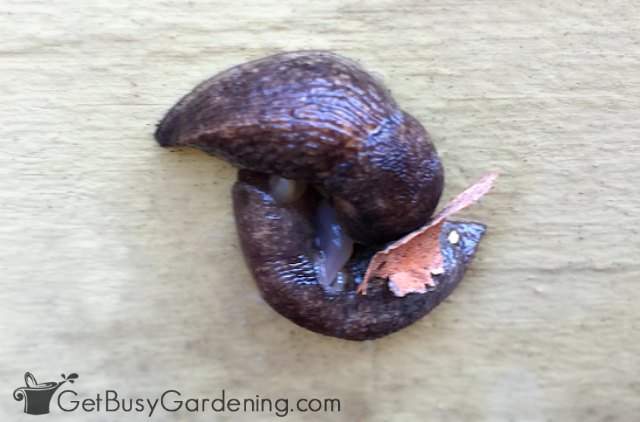
What Do Slugs Eat?
While they will eat pretty much anything, slugs do like some types of plants better than others. Some of their favorites in my garden are hostas, beans, squash, cabbage, lettuce, tomatoes, and seedlings.
You may notice that they like certain plants in your yard too. This is usually because of the location. Since slugs thrive in shady, damp areas of the garden, those are the plants they tend to feed on the most.
Damage To Plants
Slugs cause damage to plants by creating irregular-shaped holes or ragged edges on the leaves. At their worst, they can devour plants all the way down to nubs.
They can also eat the fruits and vegetables. That damage looks like perfectly rounded holes, almost like someone used a mini-melon baller on them.
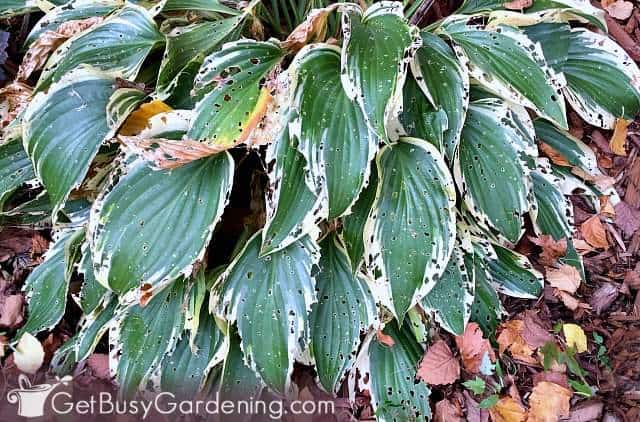
How To Get Rid Of Garden Slugs
Below I will give you several options for controlling slugs in your garden. If you’re persistent with your fight, you can successfully get rid of them.
But keep in mind that it will take more than one treatment, and you have to be diligent. Plus, you’ll have the best and fastest results when you combine several of these methods to find the perfect solution.
Related Post: Natural Garden Pest Control Remedies & Recipes
Hand Pick Them
Hand picking slugs is easy and satisfying, as long as you get the timing right. Since they are nocturnal, you’ll have to grab your flashlight and head out to the garden after the sun goes down.
They are excellent hiders, so you might have to hunt a little to find them. But their slime trails will shine in the light. So follow the slime, and you’re sure to find slugs.
They’re slow moving, and will curl up when you touch them, so they’re easy to grab. I recommend wearing disposable gloves so your hands don’t get all slimy (it is really hard to wash off!).
To kill them, simply drop them into a bucket of soapy water. You could squish them instead, but I get too grossed out doing that.
I leave them in the bucket overnight, then dump the contents into the compost bin in the morning – dead slugs and all. If you don’t have a compost bin, you can dispose of them in the weeds somewhere, or just toss them into the trash.
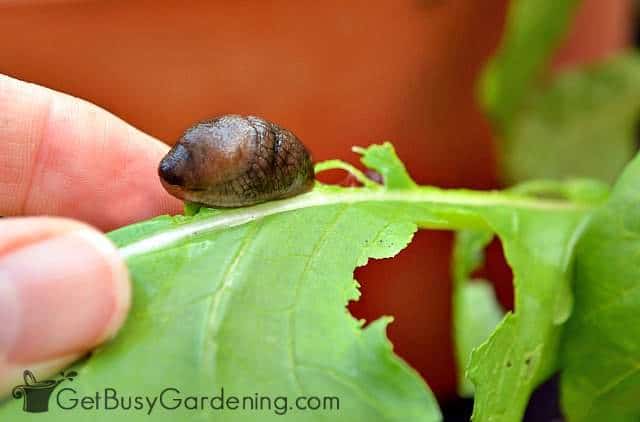
Make A Beer Trap
You may have heard that slugs love beer – and it’s true. They’re attracted to the yeast, and they can’t resist it. When they try to take a drink, they’ll fall in and drown (or maybe they get drunk and then drown, I’m not sure).
Here’s how to make a DIY beer trap:
- Sink a shallow container into the ground so the rim is at soil level.
- Fill it with beer right before sunset*.
- Leave it overnight.
- Empty the trap in the morning**.
* I’ve found that the best type of beer to use is the cheap stuff, lucky for us. But, unfortunately they like it fresh. So for the best results, you should refresh the beer daily. It can get a bit spendy.
** To empty the trap, you can pour the contents into the compost bin – beer and all. Or just throw the whole trap into the trash if it’s made of a disposable material.
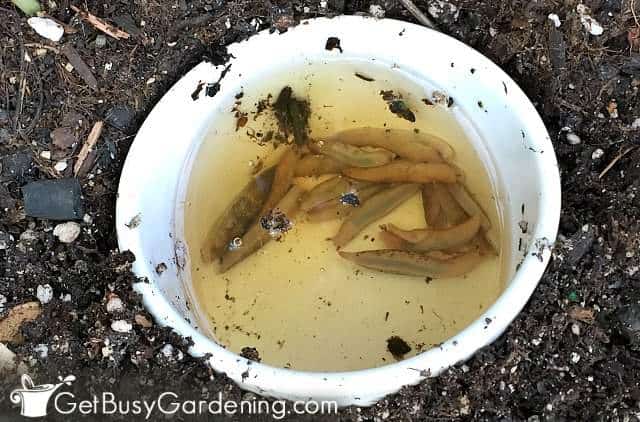
Make Traps Without Using Beer
Since slugs like damp, dark areas of the garden, you can make several different types of DIY traps. The goal is to create the ideal hiding spot to lure them in, and then hand pick them every morning. Here are a few ways to do it:
- Cardboard traps: Lay some wet cardboard or newspaper in an area that has recurring problems. These slimy pests love the damp paper, and will congregate underneath.
- Rocks, bricks, wood: Get some large rocks, bricks, or wood pieces, and place them under susceptible plants. The slugs will hide underneath, so you can simply flip them over in the morning to find them.
- Overripe fruits and veggies: They love old or rotting fruits and veggies, so you can use them as bait. You’ll likely find some slugs feeding on them in the evening or early morning.
- Plastic tarp: Since plastic traps moisture, you can cover the ground overnight with any type of tarp. When you lift it in the morning, you’ll probably find several slugs hiding underneath.
Use Diatomaceous Earth
Sprinkle diatomaceous earth (DE) around the base of the plants that slugs love the best. It will cut up their soft bodies when they slink across it, killing them.
It’s completely non-toxic and safe to use in your garden. However, the downfall of using DE is that you must reapply it after it rains.
Try Table Salt
Since salt is naturally dehydrating, it will kill slugs very quickly by drying out their bodies. Simply sprinkle it directly on them.
However, be very, very careful using salt in your garden. Too much can be harmful to your plants, or ruin the soil so you won’t be able to grow anything. Use this method sparingly.
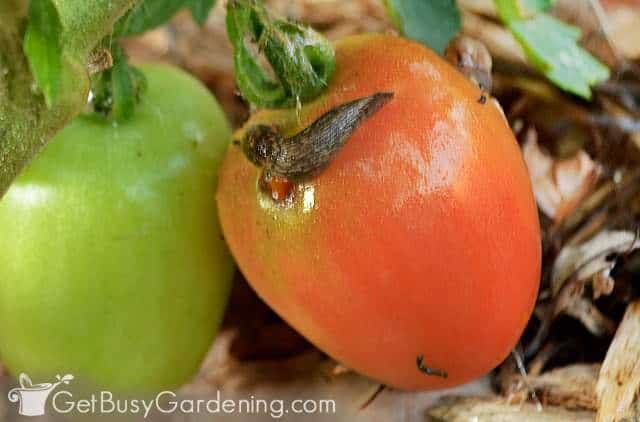
Spray Neem Oil
Neem oil is an organic pesticide that will kill slugs when they eat it. You can simply spray it on the leaves, and let it dry naturally. It has a slight residual effect, so you don’t have to spray your plants every day.
However, it doesn’t work instantly, so it may take some time before you start seeing results. But it is very effective for long-term control. Learn how to use neem oil here.
Choose Slug Resistant Plants
Though it can seem like slugs will eat anything and everything, there are actually many types of plants they don’t like. So you can grow these in areas that are plagued by recurring infestations.
They don’t like smelly plants, so they usually avoid most types of herbs, and vegetables like garlic and onions. I’ve also noticed that they don’t bother begonias, ferns, hydrangea, nasturtium, lantana, astilbe, phlox, or clematis, in my garden, to name a few.
Apply Organic Pellets
There are different types of granules or pellets that can be very effective at getting rid of slugs. You can simply sprinkle them on the ground around affected plants. They’ll eat the pellets, and then die a little while later.
But be careful, because some can contain toxic chemicals. The two organic brands that I recommend are Sluggo and Garden Safe. They’re both made with natural ingredients that are toxic to slugs, but safe for us and the environment.
How To Prevent Slugs In Your Garden
Once you figure out the methods that work the best to get rid of slugs in your garden, you’ll want to keep them from coming back. Here are a few prevention tips…
- Clean up your garden: Clearing your garden of dead plant materials and debris in the fall can help to prevent slugs from overwintering there.
- Turn your compost bin: If you have a compost bin, be sure to turn it often to prevent slugs from feeding, hiding, mating, and laying their eggs in there.
- Use lightweight mulch: Heavy mulches retain moisture, which creates the perfect breeding ground for slugs. So try using a lightweight mulch instead. This will allow the top layer of soil to dry out faster.
- Till the soil: Turning or tilling the soil in the fall will help to expose or kill any hibernating slugs and their eggs.
- Create a barrier: Copper shocks slugs when they touch it, which deters them from crossing it. So you can buy copper mesh or use a thick tape, and create a barrier around your plants, pots, or raised beds to keep them out.
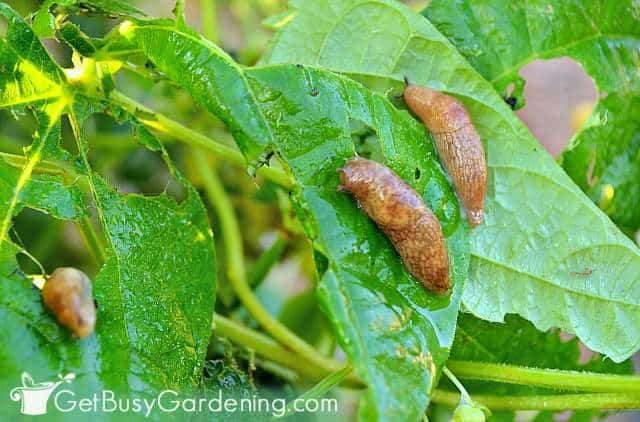
FAQs
Slugs thrive in cool, damp, shady spots. So they will be attracted to your garden if the conditions are ideal, and there’s food for them.
Lucky for us, slugs have lots of natural predators that like to eat them. Some of the most common are frogs and toads, birds, chickens, snakes, turtles, ground beetles, opossums, skunks, and firefly larvae.
Slugs usually come out at night, starting right around sunset. However, sometimes they will come out during the day in heavily shady areas, or on cool and cloudy days.
I’ve heard people rave about how using cornmeal worked to get rid of the slugs in their garden, but that is debatable. I tried it, and it’s true that they really do love eating it. But, I didn’t see any reduction in the number of slugs after a few days, and I felt like I was just feeding them. So I gave up on that method.
Slugs can’t swim, and they will drown in water or a beer trap. I don’t know how long that takes for them to drown though, so I always put a squirt of liquid soap into the water to speed things up.
Getting rid of slugs may feel like an impossible task, but it is doable. It might take some trial and error to find the best products and methods that work for you. But your persistence will pay off, so don’t give up the fight!
Share your tips or methods for getting rid of slugs in your garden in the comments section below.
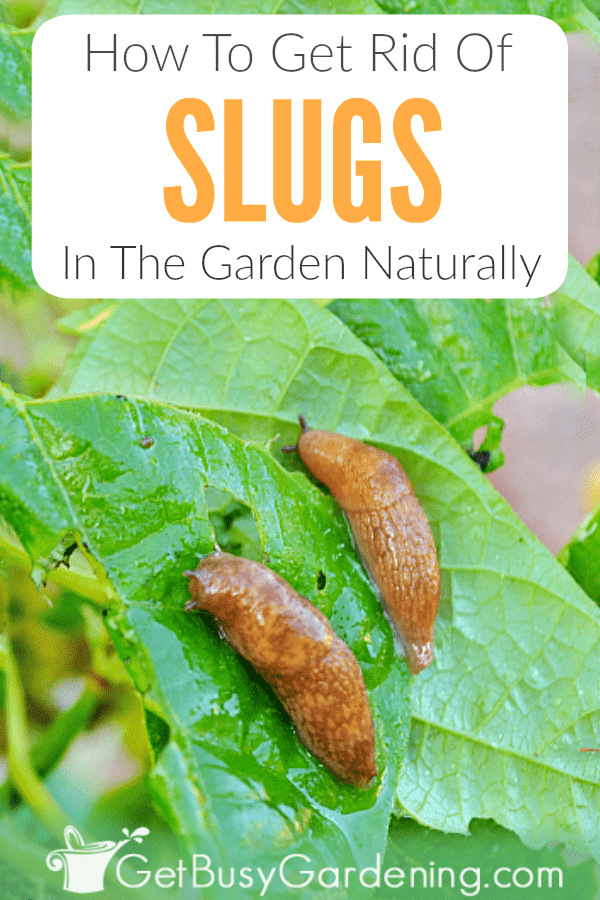
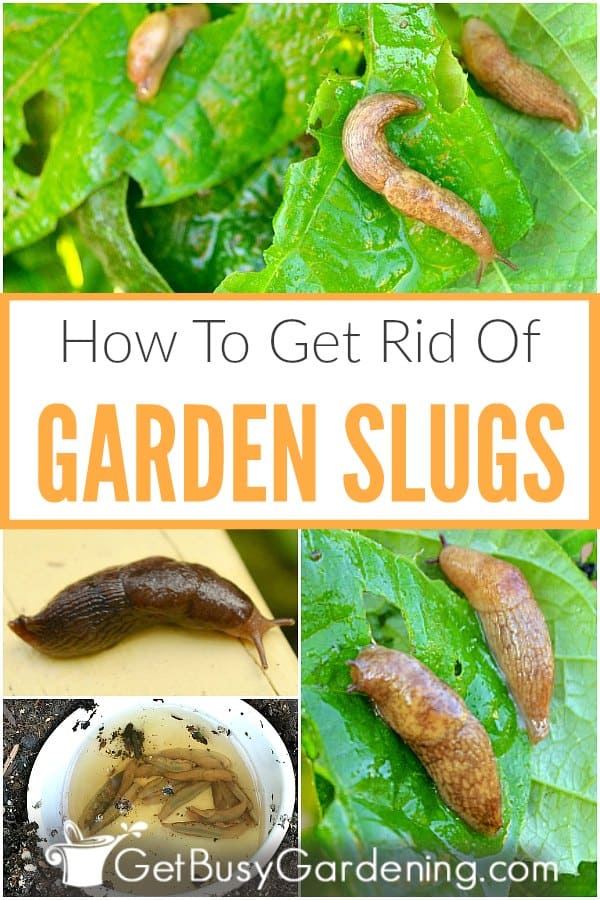
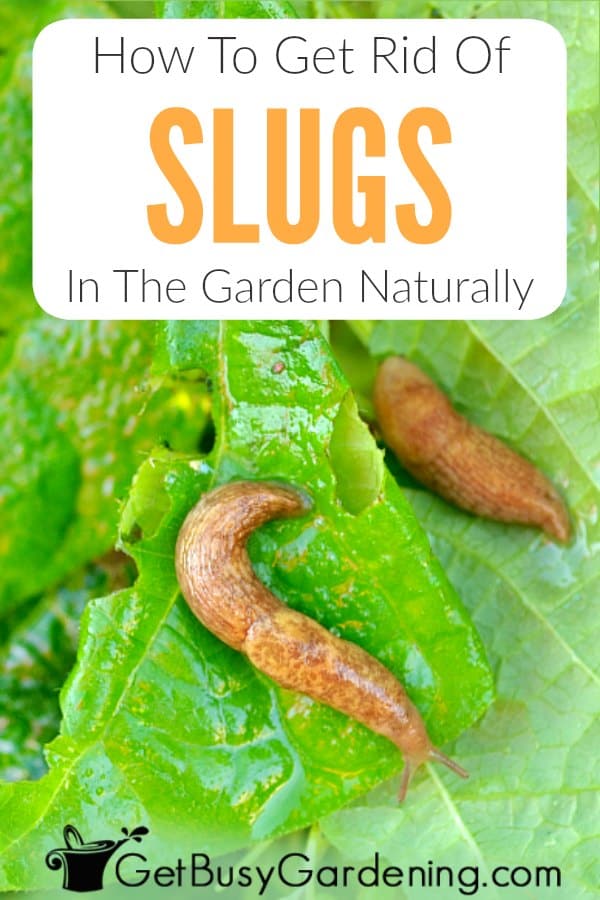
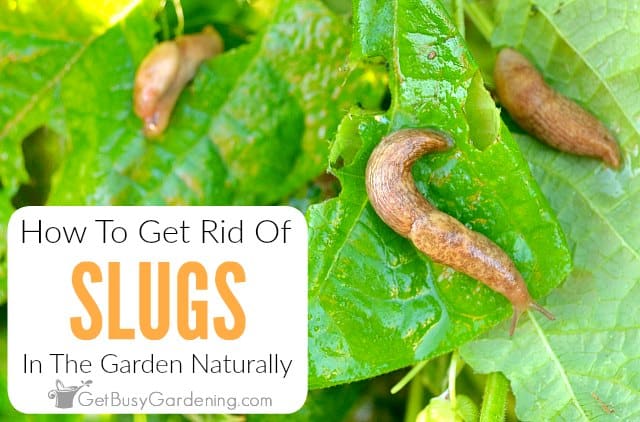

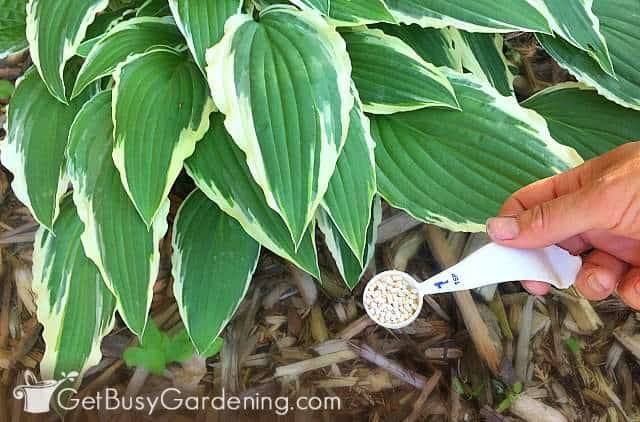

Heather Nyberg says
When I used beer traps it seemed the population grew, it was insane how many I was trapping nightly for weeks. I switched to sluggo and the problem went away entirely. Also I read that not only can beer attract the whole neighborhood but dead slugs can also attract more slugs so I would be careful how you dispose of these nasty pests.
Amy Andrychowicz says
Yes, Sluggo is the way to go in my experience too. I’m not sure why dead slugs would attract more slugs, I don’t think that tidbit of information is true. But it is a good idea to be careful with disposing them, because they can stink as they rot if there are a lot of them.
Carla says
I’ve never been able to find an answer to this
If I go out and collect slugs and snails by hand will I see a reduction of them or do more just keep coming ?
Also I’ve read they can smell beer from 200 meters away and putting out beer traps would just invite the whole neighbours slugs any truth in this ?
I grew corguettes from seed and split them into pots inside a plastic greenhouse. I was confused when the next day all pots were eaten down to the soil.
Amy Andrychowicz says
Yes, if you hand pick them, you will help to reduce their population for sure. However, if there’s a very large amount of them in your yard, then it might not feel like you’re making any progress. Many times you have to use a variety of treatment methods to see progress, and definitely keep up on it regularly.
I have no idea how far away they can smell the beer, and I’ve never heard the 200 meter thing before. But if what you read were true, then my beer traps would be overflowing. So, I suspect that is just a myth.
Ann douven says
Just came in from handpicking slugs found 50 tonight in my raised veggie beds but last week after 2 days of rain we hit the jackpot total of 130 in one night and we only have 6 raised beds. I was searching about using Neem oil and came across your site and a big thankyou as I was beginning to lose hope. All the comments inspired me to keep keeping on so thankyou from a forest in Belguim and now I will search for nematoides.. happy hunting slug patrollers
Amy Andrychowicz says
Holy cow, that is a LOT of slugs! Yuck, sorry to hear that your garden is so infested. Definitely try both the beneficial nematodes as well as the Sluggo product I mention in the post. I’ve had great results with both of them. The Sluggo will work quickly, while the nematodes will be slower, but a longer-term solution. Good luck!
Deb says
My mother was an avid organic gardener. When she had a problem with slugs, she would place one or more shallow tinfoil pie plates where the slugs congregated in the garden and fill them halfway with beer. In the morning, the pie plates would be full of dead slugs.
Amy Andrychowicz says
Yes, slugs love beer! I’ve had great success with this method too.
M ludke says
I have used coffee grounds, diatematious earth, egg shells as well as getting out there and spraying any slugs I find with a mix of ammonia and have not seen a reduction in slugs… I’m ready to dig all my perennials up , and wondering if there is any thing I could treat the soil with to kill whatever larvae is left in the fall?, and how deep do the critters nest?
Amy Andrychowicz says
Ugh, sorry to hear that your battle with slugs has not been working. 🙁 That’s super frustrating. I have found great success using the Sluggo product that I mentioned in the article, and then spraying beneficial nematodes at least once a year for longer term control.
Kristina B says
Slugs love phlox. In fact, when I moved into my current house (built on swampy land so perfect for slugs unfortunately), I discovered our slug problem when I went outside on the fourth of July to watch the fireworks and at some point shined a flashlight over at my tall garden phlox…whose entire bloom top was covered with some many slugs that the plant was bending over and the bloom appeared to be GRAY/BROWN. I have also seen the tell tale signs of slugs in the leaves, and especially the flowers, of my clematises. If I don’t surround the plants with a “mulch” of egg shells, they will eat blooms off before I can even enjoy them.
James says
You don’t mention using beneficial nematodes as a method of controlling slugs! I have used a product called NemaSlug, and this is a natural product which is dispersed in water and sprinkled on the ground. It contains millions of live nematodes which attack the slug larvae underground, so you don’t even need to worry about getting rid of the dead slugs. What’s more, while attaching slugs, the nematodes multiply, and you get a fresh army of them seeking out new slug larvae! It works for me, and I hardly ever see any slugs now in my garden!
Amy Andrychowicz says
Great to hear that nematodes have worked to help you control slugs in your garden! Thanks for sharing your experience and product recommendation. That is very helpful.
James says
I’m not sure if they’re available in the States though?
Amy Andrychowicz says
I don’t know if we have the specific brand, but we can buy beneficial nematodes here under several other brand names. 🙂
Kristina B says
I’m curious if mosquito bits will work! Sounds very similar to nemaslug. It’s like…corn kernels that are coated in beneficial nematodes. You can put them in bird baths and pools and standing water places to kill mosquito larvae, but I soak them in my watering can to water my indoor plants when I see signs of fungus gnats to kill gnat larva in the soil. Now I wanna treat my whole yard! It isn’t nearly as pricey as buying beneficial nematodes from any of the places I’ve looked this past year so may be more doable for more people.
Amy Andrychowicz says
I’m not sure if that would work for slugs or not, you’d have to read the label. Also, it’s not an organic product, so definitely be careful with it. It’s never a good idea to do any type of broad applications in your garden and yard, especially with chemicals, because they aren’t good for humans or pets, and you never know what other good bugs you’re killing in the process unfortunately.
Chip says
Amy, thanks for the post and for the comment replies. We recently purchased a home and I immediately started planting a small garden. I was shocked to see how quickly my young pepper plants and basil were being devoured. Basil specifically surprised me as I didn’t think pests were attracted. At the advice of my local nursery, I’ve spread Sluggo.
Have you experienced slugs chomping on herbs, specifically basil? Thanks!
Amy Andrychowicz says
Oh bummer, sorry to hear that the slugs decimated your plants. That’s a huge bummer! I have not had issues with them eating my herbs, but it doesn’t surprise me that they ate your basil. This time of year, food is scarce, so they can’t be as picky as they are once everything else starts to grow. Hope the Sluggo helps, it has worked well in my garden.
Capt. Brigg Franklin says
I grind up egg shells in a small coffee grinder used for only that purpose. Don’t use the same grinder for your coffee, as the ground up shells are also bad for you if swallowed. Then sprinkle the ground up shells on the ground around your plants. The ground shells will cut the slugs and either kill them or prevent them from crossing the barrier. The egg shells can also add calcium for plants like tomatoes that require it for proper fruit set.
Amy Andrychowicz says
Awesome, thanks for sharing your favorite slug control method. It’s great to hear that the crushed eggshells work for you!
Ash says
I sprinkle mealie meal or cornmeal as it is called in some countries. Slugs eat it and then die off. I have much less in my garden at the moment. But my garden is huge and I have to do the whole place. So far I have only been sprinkling the cornmeal in some of the beds. But I do see less slugs and less damage, so its working. I also collect and dry all my eggshells in the sun before crushing and use that around plants. The kids love to do the crushing part, I place all the shells in a plastic bag and they stomp on it to crush.
Amy Andrychowicz says
Good to hear that the cornmeal slug control method has worked in your garden. I tried using cornmeal in my garden last summer, and the slugs sure do love it. I could see them devouring it when I went out to check the garden at night. Though, I’m not sure it helped. I just felt like I was feeding the slugs, LOL! To be fair, I did only try it twice, so probably not long enough to make a huge difference.
Ruth Anne says
I have flagstone all around the area that is filled with hostas. I discovered that slugs love to hide under the stones, so it was a simple job to flip the stones one at a time and kill the slugs underneath. I have been doing this for the past 2 summers – it’s amazing how effective this has been.
Amy Andrychowicz says
Oh, good to know that the stones in your garden made natural slug traps! That’s wonderful, and a great slug control tip.
Sugar says
When I lived up in the cities, the slugs destroyed my hosta's! They ate them right down to the center vein. I experimented with several treatments, but the diatomaceous earth worked best for me.
Amy Andrychowicz says
Wonderful, so glad to hear the diatomaceous earth worked for slug control. Thanks for sharing your experience.
Mia says
If you have a sandbox, you can sneak a couple of cups of sand to sprinkle around the base of the plant to help deter slugs. But don't let your kids see you sneaking sand out of their box. They might get mad. Ahem, not that I would know from personal experience or anything. Ahem.
Amy Andrychowicz says
LOL! Thanks for the tip about using sand around the base of plants to deter slugs! Does this method work for you?